Whatever your culinary leanings, or even if you have no particular interest in things culinary at all, it would be hard to miss the buzz about “Modernist Cuisine”, Nathan Myhrvold’s big, bold, and beautiful take on exploring science and technology in the kitchen. It’s been featured virtually everywhere, including the pages of magazines like Time and Newsweek.
Modernist Cuisine
Co-authored with Chris Young and Maxime Bilet, Modernist Cuisine was launched in March 2011. The six volume set is the result of four years and many thousands of hours of work by a team of specialists drawn together by Myhrvold to capture and illustrate his vision. (You can read all about it on the Modernist Cuisine blog).
Weighing in at nearly 20 kgs, Modernist Cuisine is a big work in every sense. It’s mighty impressive to look at and, for all the chemistry and physics in there, surprisingly easy to read whether you’re a rocket scientist, or just a food science enthusiast like me.
But, there is something else that engaged my interest in Modernist Cuisine – an Indian connection, and a Coorg one at that – Chef Anjana Shanker (née Bidappa), who is one of the four research chefs on the Modernist Cuisine team.
I’m delighted to be talking to Chef Anjana Shanker about current events in her professional life.
But first, a little history
As children heading to Coorg on our annual visits from far corners of the country, we knew we were on the final stretch of our long, wearying journey by plane, train, and automobile, when a butter yellow wall on the crest of a short slope hove into view. This was the compound wall of the Bidappa home. As we drove up, we’d sometimes catch a glimpse of our cousins who lived there, leaning over for a quick exchange of waves before the car turned the corner and drove up the slope to the house next door. We could barely wait for the car to come to a halt before spilling out, wobbly with relief and excitement. There’d be plenty of time to catch up with everyone over the course of the holidays!
It’s not so easy to catch up with everyone anymore. We’ve scattered in different directions, and the world seems a much busier place now. So, I was pleased to hear that the youngest of those cousins next door, Anjana, had moved to Seattle, WA – almost next door to my home in Vancouver, BC. Given the busy pace of modern life, conflicting schedules and missed opportunities, when we eventually got to meet there was much to catch up on. In the process of filling in the gaps in the years since we’d last met, I discovered Anjana and I shared a childhood passion for baking, and she recalled how she was often called upon by family and friends to fix various cake emergencies! We also found that we’d both spent many hours trying to perfect an aunt’s famous chocolate fudge recipe.
In conversation with Chef Anjana Shanker
Anjana spent her childhood in Mercara, attending St Joseph’s Convent. After moving to Madras (now Chennai) and completing a BA in History and Economics, Anjana worked for Nestlé, and then Singapore Airlines. Her desire to go to catering school in Switzerland had been put on the back burner, but the call to do something related to food and cooking was always present. She credits her late brother, Arun Bidappa, with recognizing her talent and really encouraging her to pursue her culinary ambitions. While in Madras, she considered opening a café, a student friendly place. Hard to believe today, with a Barista or Coffee Day at every corner, but that was something that was sorely lacking in the city at the time.
After getting married, Anjana moved to the United States, to Scottsdale, AZ. Here, the perfect opportunity presented itself in the form of the Scottsdale Culinary Institute, where she enrolled. After graduating with honours with an Associate of Occupational Studies Degree in Le Cordon Bleu Culinary Arts and Sciences and Restaurant Management, she began her journey as a professional chef.
CYC: Growing up in a culinarily gifted family, the youngest of five siblings, whom were you most inspired by?
Anjana: My mother, Leela Bidappa, was the primary inspiration. When it came to cooking for the family, mother was very resourceful, using seasonal ingredients that were readily available in her garden or in the estate. She and her neighbours were always in touch, exchanging notes on recipes and planning their kitchen gardens. They decided who would grow what vegetables that year and share the harvests. This approach to using local ingredients has remained with me to this day.
My brother Arun was instrumental in motivating me to pursue my interest in the culinary field. He encouraged me to get the culinary degree at Le Cordon Bleu College of Culinary Arts in Scottsdale, Arizona.
Straight out of cooking school, the first job Anjana held was in Mary Elaine’s (now closed) in Scottsdale, a high-end restaurant serving French food. Here, she got to put into practice the classic techniques of cuisine she’d studied at the Cordon Bleu.
CYC: Can you tell us about your work at Mary Elaine’s?
Anjana: Mary Elaine’s was a fine dining Modern French Restaurant, located at the Phoenician Resort, Arizona. Mary Elaine’s was a Mobil Five-Star and Five Diamond awards restaurant. Soon after graduating from culinary school, I commenced work under Chef James Boyce and then worked under Chef Bradford Thompson.
I honed my culinary skills working at Mary Elaine’s, gaining extensive knowledge about fine dining. The training I received brought out my creative instincts, and made me focus on the finer details of preparing and plating a dish.
Anjana worked at Mary Elaine’s for 3 years before moving to Seattle, WA. Here, she began work at Lampreia, working for Scott Carsberg.
Anjana: Lampreia is now called Bisato. I must say it was more European Italian influenced food. Chef Scott Carsberg is a very creative and inspiring chef. His food appears simple but is rich in flavor and each dish is distinctive in creation. His menu changed with the seasons.
Working at Lamperia (Bisato) was a very creative and positive experience.
Working with Chef Scott taught me to keep things simple, using few ingredients, that were seasonal and locally sourced.
In 2005, Anjana took a year off to spend time with family in India. Back in Seattle, she once again mulled over the idea of starting her own restaurant but the timing didn’t seem right.
Looking around for something interesting and challenging to take on, Anjana spotted a small advertisement on Craigslist for chefs with work experience. On a whim, she headed off for the interview, little realizing that what she was about to walk into, would prove to be more interesting and challenging that her wildest imaginings!
Anjana: The interview was actually in a huge warehouse, filled with all kinds of scientific equipment, and there was even a skeleton hanging around somewhere – I had never seen anything like it!
If she had any misgivings, she kept them at bay long enough to go through the interview and she landed the job. What she had walked into was the beginnings of the test kitchen and laboratory of Nathan Myhrvold’s mega project “Modernist Cuisine”! The kitchen, or, The Cooking Lab, as it’s known, shares space with a number of other non-culinary research facilities, which might just explain the odd skeleton rattling around!
One of four research chefs, the others being Grant Lee Crilly, Sam Fahey-Burke, and Johnny Zhu, hired full-time for the project, Anjana began working on what was to be an intensive, 3 1/2 years of research, testing, and recipe development. Her work also included food styling for the striking photographs by Ryan Matthew Smith and Nathan Myhrvold that are such a major component of the Modernist Cuisine experience.
Speaking of her fellow research chefs, Anjana says “we get along really well as a team, and that’s important in what can be a stressful environment.“
In a kitchen that moves between laboratory, tool room, and art studio, it’s clear that a lot of multi-disciplinary skills come into play. Working with liquid nitrogen and handling equipment like a rotary evaporator was a long way from the classic techniques of the Cordon Bleu she had been schooled in. Centrifuging carrot juice, or sandblasting oyster shells for the perfect presentation, it’s all in a day’s work for Anjana.
CYC: How many years did you work from start to finish up to the publishing of MC?
Anjana: Starting in 2008, I have been working for 3 ½ years at Modernist Cuisine, Cooking Lab.
CYC: What was the most challenging part of the work you did in the research team of MC and, also, the most rewarding?
Anjana: The most challenging part of the project was to analyze and understand the technical aspects of the science of cooking. While we take everyday cooking for granted, the project made me aware that there is science in all aspects of cooking. It was very challenging and rewarding to research and test a traditional culinary recipe and apply modernist principles to create a dish. I had no formal higher education in science, so I had to do a lot of reading to get up to speed.
The most rewarding part is the visual explanation of ingredients; using only seasonal ingredients; and preparing recipes with scientific knowledge and modern techniques; extensive use of modernist techniques to create new forms of foods, starting with traditional ingredients. At the same time, traditional cooking techniques – braising, brining, curing and smoking – were applied to modern methods, like sous-vide, the use of centrifuge, hydrocolloids and dehydration.
Modernist cuisine breaks things down so that you better understand the “what” (ingredients) and the “how” (techniques), and also why particular applications of culinary principles work.
During our book launch visit to New York, I had the opportunity to meet Chef Ferran Adria. At the Modernist Cuisine Cooking Lab, I met Chef Helson Blumethal, Chef Thomas Keller and Harold McGee, to name a few.
In addition to the authors Nathan Myhrvold, Chris Young and Maxime Bilet, there are four research chefs, including me. My fellow research chefs are Grant Lee Crilly, Sam Fahey-Burke, and Johnny Zhu. I must say I have the opportunity to work with the most talented chefs, who reflect their diverse backgrounds and distinctive experiences. It is such an honor to be part this team.
CYC: Now that MC is published, what happens at work?
Anjana: We still promote Modernist Cuisine and host dinners at the Cooking Lab, always featuring recipes from the cookbook.
We are in the process of creating step-by-step procedures for new recipes for the MC blog. We still do recipe development and test recipes with new ideas.
Anjana’s too modest to mention it, but there’s a distinct Indian component in Modernist Cuisine, thanks to her contributions. Myhrvold is passionate about barbecue (world barbecue champion, anyone?). Following an extensive period of testing regional variations in barbecue recipes from across the US, Anjana suggested the team try a modernist take on some Indian classics. To quote the authors, “she reasoned that Indian curry dishes, like American barbecue, come in a vast variety of regional styles. The recipes she came up with were so good that we had to put them in the book. They illustrate how even culinary traditions stretching back hundreds (or in some cases, thousands) of years can be revisited with a Modernist palate and sensibility – to delicious and thought-provoking effect.“
She’s also introduced the team to the delights of chaat masala!
CYC: Would you like to share some favourite foods and recipes, Coorg or otherwise?
Anjana: Here are links to a couple of my favorite recipes from Modernist Cuisine:
Caramelized Carrot Soup (recipe)
Some of my favourite Coorg dishes are baimbalé (bamboo shoot) curry, maangé (wild mango) curry, lamb pulaav and nuuputtu with mutton curry.
Some of my favorite foods from my childhood are koilé meen cutlets*. When I visited my maternal grandmother, I used to go to the paddy fields and try to catch koilé meen. Pulikuul paaka** and chocolate fudge are other favorites from my childhood. Some of my father’s cousins were excellent at baking pastries, cakes and cookies, which inspired and motivated me to bake at a very young age.
* Fish cakes made with kind of small fish found in rice fields flooded with water from streams or rivers.
**A spicy chutney made with a bitter-sweet citrus fruit, similar to a Seville orange.
CYC: What would you like to have cooked for you – a perfect meal?
Anjana: A perfect meal would be when my husband surprises me with a home cooked meal. 🙂
I love traditional south Indian food. My perfect meal would be at my friends’ farm in Tamil Nadu, where all ingredients are from their farm – rice, vegetables and meat.
The chef at home
In her home kitchen in Seattle, I watched Anjana as she cooked as perfect a meal as it gets, starting with a luscious roasted cauliflower soup seasoned with truffle salt, followed by creamy mashed potatoes with chantrelles, panko crusted Icelandic lamb chops, and herbed quinoa. There was also a lovely beet and arugula salad accented with nigella. No Modernist surprises*, just a harmonious medley of colours, textures and flavours, pulled together with an easy grace.
As for her future plans, Anjana thinks there might still be a café in it, somewhere, and possibly a cookbook, among other things.
Whatever she undertakes, here’s wishing her all the very best!
* Though we did get to taste some extraordinarily good sous-vide pastrami.
Chef Anjana Shanker shares her take on a Coorg classic, Yerchi Bartha Kari, a dry fried mutton or lamb dish:
Coorg Lamb (Mutton) Chops
Serves: 6-8
- 6 -8 Lamb (or Mutton) chops
- ½ tsp fresh turmeric (or powder)
- 1 tsp Kaachampuli
- ½ tsp chili powder
- 1 Tbsp olive oil
Combine turmeric, kaachampuli, olive oil and chili powder in a bowl. Toss the lamb chops and mix to coat the chops and let it marinade for 30 minutes.
Spice for lamb chops:
- 8 small red pearl onions
- 8 garlic cloves
- ½ inch ginger
- 4 cloves
- 2 tsp white poppy seeds
- 1 small cinnamon stick
- 3 green chilies
- 2 tsp black peppercorns
- 2 cardamom pods
- ¼ cup coconut milk (light)
- ¼ cup cilantro leaves
Combine and grind to a fine paste.
To cook lamb chops:
- Ground spice from above
- 1 cup of water (or substitute coconut milk)
- 1 Tbsp of Kaachampuli
- Cilantro leaves or mint leaves for garnish
- Crispy shallots (optional) for garnish
Heat the oil in a cooking pot, add the finely ground spices and cook on low heat for about 2 – 3 minutes, or until aromatic.
Add marinated lamb chops and fry for about 10 minutes, stirring constantly. Add 1 cup of water and cook on low heat until almost dry. Season with salt and cook until the meat is tender. (There should be very little gravy left in the pan). Add kaachampuli and remove from heat. Granish with crispy shallots, cilantro and mint leaves. Serve with roasted potatoes or roasted vegetables.

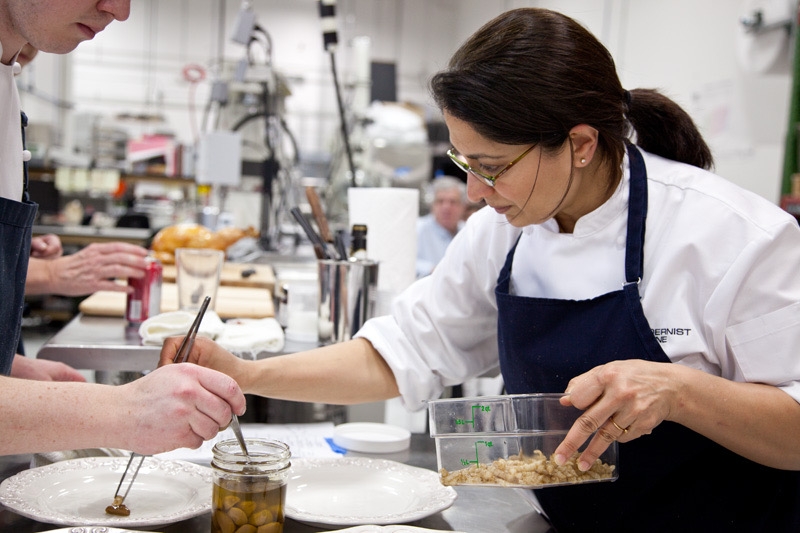

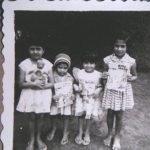

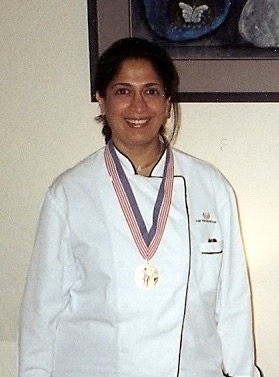
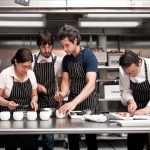
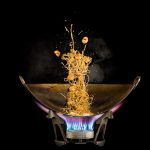

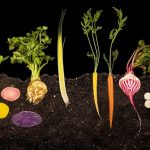
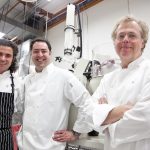
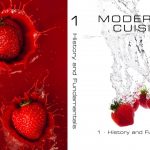
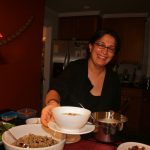
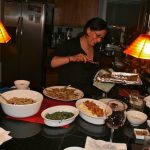
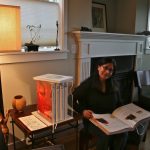
Your fabulous writing does justice indeed to Anjana. Cooking is a science, even the way nutrients need to be combined but has to be done form the heart, not cutting corners atall order for a working mum with grownig kids . I love almost all regional cusines of India, the food cooked in a middle class home or even a village . The commercialised versions of classic, s not all work . But innovations and modern approaches when intelligently done are just worth licking the plate . Your Thambuttu cookies are a delightful case in point . It will be wonderful to have restaurants which serves authentic regional fare sans the overdose of masala , oil and chilly and of course innovative new versions too . Fresh regional ingredients that is how they cooked in the good old days slow cooked with dollops of love . The art of pickling , curing meat has been done for centuries , is based on science and leaves no margin for error . Modernist Cooking takes it to an absolutely new level . I am a amazed at how much passion and intelligence cooks like Anjana bring to the table . This was such a wonderful post. Keep sharing your recipes , these lamb chops are simplicity itself to produce a perfect dish with the ingredients any kitchen will always have . And the pics , it is a delight to see a Cordon Bleu chef cook with such a lovely smile , and the childhood pic , gosh the moppets holding up their trophies , Made me smile and smile and then again smile some more .
Hola Shalu,
What a great interview with Anjana. That little history section induced much nostalgia; felt as if I was chatting over that old butter-yellow wall all over again! Anjana has obviously honed her talent and passion through sheer hard work. I’m sure this is not the last we’ll hear of her considerable accomplishments as a chef.
Tried out the Thambuttu cookies and they were wonderful. Just the perfect ‘taste of Puthari’ for those of us with mashed banana phobia!
We’d love more of these variations on traditional recipes…keep writing and photographing.
Hi Jyoti, Devika,
I’m glad you both enjoyed reading about Anjana’s “story so far”!
As Devika pointed out, her talent and passion have been backed by a lot of hard work and that’s what has brought her to this point in her career.
Jyoti, you might just have opened a can of Modernist gummy worms with that statement about getting nutrients into growing kids;-)
Thanks for reading, and for the feedback on the thambuttu cookies!